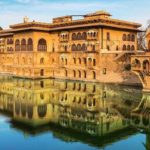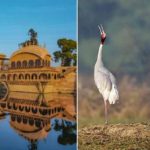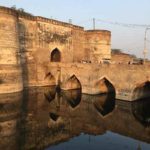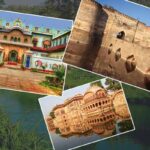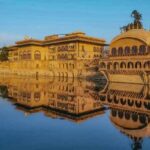Monuments in Bharatpur, located in the Indian state of Rajasthan, boasts a rich tapestry of historical and cultural monuments that reflect its royal heritage and architectural splendor. One of its most renowned attractions is the Keoladeo National Park, also known as the Bharatpur Bird Sanctuary, a UNESCO World Heritage Site famous for its diverse avian population, including migratory birds.
The city is adorned with majestic forts and palaces, such as the formidable Lohagarh Fort, known as the Iron Fort, built in the 18th century by Maharaja Suraj Mal. The Ganga Mandir, dedicated to Goddess Ganga, and the Laxman Mandir, dedicated to Lord Laxman, showcase intricate marble carvings and architectural grandeur.
Bharatpur also houses the Government Museum, offering a glimpse into the region’s history and culture, and the Bharatpur Palace, a blend of Mughal and Rajput architectural styles. Nearby, the Deeg Palace serves as a summer retreat with its lush gardens and magnificent water fountains.
The city’s skyline is punctuated with historical landmarks like the Jawahar Burj and Fateh Burj, victory towers commemorating Maharaja Suraj Mal’s triumphs. Other notable monuments include Gopal Bhavan within the Bharatpur Palace complex, the historic Government Press, Moti Mahal, and Kakaji Ki Kothi, each contributing to Bharatpur’s rich cultural heritage and attracting visitors from around the world.
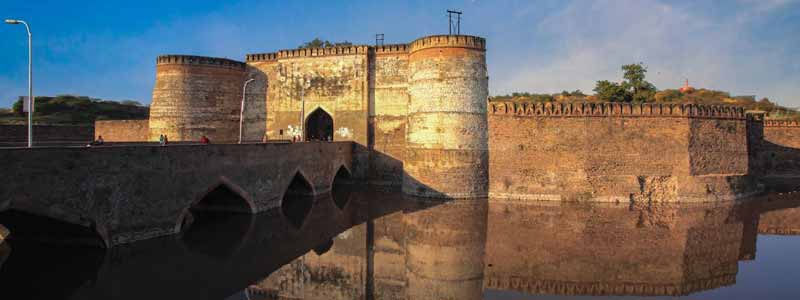
Lohagarh Fort
Lohagarh Fort, also known as the Iron Fort, stands as a testament to the indomitable spirit of the Bharatpur region in Rajasthan, India. Constructed in the 18th century by Maharaja Suraj Mal, this formidable fortress is renowned for its impregnable defenses and robust architecture, which allowed it to withstand numerous attacks by British forces.
The name “Lohagarh” translates to “Iron Fort,” symbolizing its strength and resilience. Unlike many other forts in Rajasthan, Lohagarh Fort is not adorned with intricate carvings or lavish palaces; instead, its beauty lies in its simplicity and solid construction, Rajasthan Monuments.
The fort is surrounded by massive walls made of solid iron plates and earthworks, which provided unparalleled protection against enemy artillery and siege tactics. Its strategic location and innovative defensive features earned it the reputation of being one of the strongest forts in Indian history.
Within the fort complex, visitors can explore various structures, including the Ashtadhatu (eight-metal) gate, Kishori Mahal, and the towers of Jawahar Burj and Fateh Burj, which commemorate the victories of Maharaja Suraj Mal.
Today, Lohagarh Fort stands as a proud symbol of Bharatpur’s rich heritage and its people’s valorous history, attracting tourists and history enthusiasts from around the world to marvel at its majestic walls and learn about its storied past.
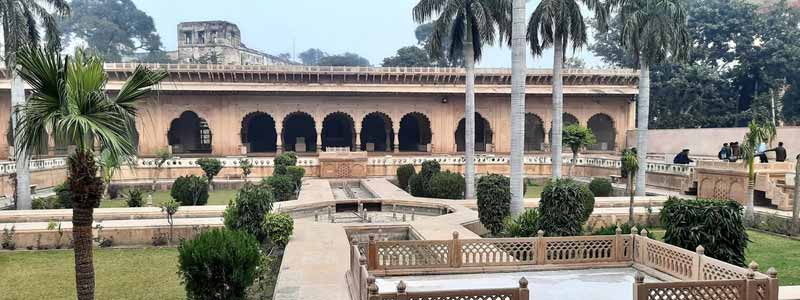
Government Museum Bharatpur
The Government Museum in Bharatpur, Rajasthan, stands as a testament to the rich cultural heritage and history of the region. Established with the aim of preserving and showcasing the diverse artifacts and historical treasures of Bharatpur and its surrounding areas, the museum offers visitors a captivating journey through time.
Housed within a majestic building, the museum’s architecture itself is a sight to behold, reflecting a blend of Rajput and Mughal styles. Within its walls, visitors can explore a vast collection of artifacts spanning various periods, including sculptures, coins, paintings, weaponry, and archaeological finds. Each exhibit tells a story of the region’s vibrant past, from its ancient civilizations to its medieval kingdoms and colonial eras.
One of the highlights of the museum is its collection of sculptures, which includes intricately carved pieces depicting Hindu gods and goddesses, as well as Jain and Buddhist deities. These sculptures not only showcase the artistic prowess of ancient craftsmen but also provide insights into the religious and cultural practices of bygone eras.
The museum also houses a remarkable collection of coins, offering a glimpse into the economic history of the region. From ancient coins dating back to the Kushan and Gupta periods to medieval and modern currency, the collection provides valuable insights into the region’s trade and commerce over the centuries.
Overall, the Government Museum in Bharatpur serves as a treasure trove of knowledge and a must-visit destination for history enthusiasts and cultural aficionados alike, offering a comprehensive overview of Bharatpur’s rich and illustrious past.
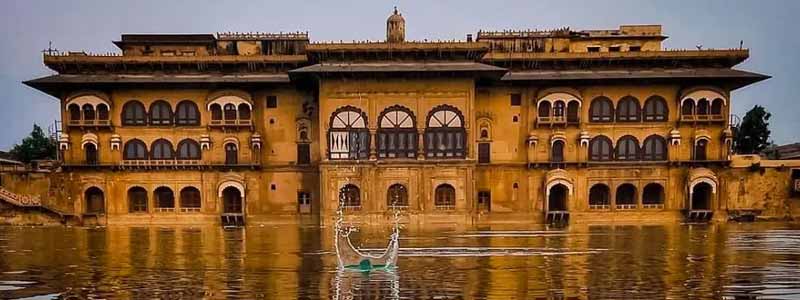
Deeg Palace
Deeg Palace, situated near Bharatpur in the Indian state of Rajasthan, is a magnificent historical complex that served as the summer retreat for the rulers of Bharatpur. Constructed in the 18th century by Maharaja Suraj Mal, this sprawling palace complex is renowned for its architectural grandeur, stunning gardens, and intricate water fountains.
The palace complex comprises several structures, including a series of beautiful palaces, pavilions, and gardens. One of the highlights of Deeg Palace is its impressive water fountains, which are ingeniously designed to operate without the use of any modern machinery. These fountains, known as the “jal mahals,” are activated by a sophisticated hydraulic system that utilizes gravity to create mesmerizing water displays.
The palace’s architecture reflects a blend of Mughal and Rajput styles, characterized by intricately carved marble, delicate lattice work, and vibrant frescoes. Each structure within the complex offers a glimpse into the opulent lifestyle of the Bharatpur royalty.
The sprawling gardens surrounding the palace are meticulously landscaped and feature a variety of flora, adding to the palace’s charm and beauty. These gardens served as a retreat for the royal family and provide a tranquil ambiance for visitors to explore.
Today, Deeg Palace stands as a testament to Rajasthan’s rich architectural heritage and attracts tourists from around the world who come to admire its beauty and historical significance.

Keoladeo National Park
Keoladeo National Park, also known as Bharatpur Bird Sanctuary, is a renowned avifauna sanctuary and a UNESCO World Heritage Site situated in Bharatpur, Rajasthan, India. Covering an area of approximately 29 square kilometers, this park is famous for its diverse birdlife, particularly during the winter season when it becomes a haven for migratory birds.
Originally a natural depression formed by the confluence of the Gambhir and Banganga rivers, Keoladeo was transformed into a bird sanctuary in the 18th century by the Maharajas of Bharatpur. Its name is derived from the ancient Keoladeo temple dedicated to Lord Shiva, which is situated within the park.
The park’s diverse habitat, including wetlands, woodlands, grasslands, and shallow lakes, provides a crucial refuge for over 350 bird species, including indigenous birds like painted storks, herons, cormorants, and the rare Siberian crane. During the winter months, thousands of migratory birds, including ducks, geese, and waders, flock to the park from regions as far as Siberia, Central Asia, and Europe, Monuments in Bharatpur.
Apart from its avian diversity, Keoladeo National Park is also home to various mammal species like the spotted deer, sambar, nilgai, and wild boar, as well as reptiles and amphibians.
Visitors to Keoladeo National Park can explore its picturesque landscape through guided walks, cycle rides, or boat rides, offering a unique opportunity to witness the rich biodiversity and ecological significance of this natural sanctuary.
Ganga Mandir
The Ganga Mandir in Bharatpur, Rajasthan, stands as a testament to exquisite architecture and deep religious reverence. Constructed in the 19th century by Maharaja Balwant Singh in honor of the Hindu deity Ganga Devi, this temple is a remarkable blend of Rajput and Mughal architectural styles.
The temple’s exterior is adorned with intricate carvings and sculptures, showcasing the skilled craftsmanship of the artisans of that era. Its majestic spires and ornate domes rise elegantly against the sky, drawing visitors and devotees alike, Monuments in Bharatpur.
Upon entering the temple, one is greeted by a serene ambiance and a sense of spiritual tranquility. The inner sanctum houses a beautiful idol of Goddess Ganga, intricately crafted and adorned with jewels. Devotees offer prayers and perform rituals with heartfelt devotion in this sacred space.
The Ganga Mandir holds significance not only as a place of worship but also as a cultural and architectural marvel, attracting visitors from far and wide. Its timeless beauty and religious significance continue to enchant all who visit, making it a cherished landmark in Bharatpur’s cultural landscape.
Banke Bihari Temple
The Banke Bihari Temple in Bharatpur is a revered Hindu temple dedicated to Lord Krishna, particularly in his childhood form as Banke Bihari. Situated in the heart of Bharatpur city in the Indian state of Rajasthan, this temple holds immense religious significance for devotees, attracting a large number of pilgrims throughout the year.
The temple’s architecture follows traditional Hindu temple design, featuring intricate carvings and colorful artwork that adorn its walls and ceilings. Inside the temple, the main deity, Lord Banke Bihari, stands in a captivating idol form, attracting devotees who come to offer prayers, seek blessings, and immerse themselves in devotional activities.
The atmosphere inside the temple is filled with spiritual fervor, especially during festivals like Janmashtami (Lord Krishna’s birthday) and Holi, when the temple comes alive with vibrant celebrations and devotional songs dedicated to Lord Krishna, Monuments in Bharatpur.
Devotees believe that worshipping at the Banke Bihari Temple brings peace, prosperity, and fulfillment of desires. The temple also serves as a center for various religious and cultural activities, including bhajans (devotional songs), kirtans (religious chants), and discourses on Hindu scriptures.
Overall, the Banke Bihari Temple in Bharatpur is not only a place of worship but also a symbol of devotion and spiritual heritage, deeply ingrained in the cultural fabric of the region.
Jawahar Burj and Fateh Burj
Jawahar Burj and Fateh Burj stand as proud testaments to Bharatpur‘s rich history of valor and resilience. Constructed by Maharaja Suraj Mal, these two towering structures symbolize his victories over the Mughal and British forces, marking significant milestones in the region’s history.
Jawahar Burj, translating to “Victory Tower,” commemorates Maharaja Suraj Mal’s triumph over the Mughal Empire. Rising majestically, it serves as a reminder of Bharatpur’s defiance and military prowess against formidable adversaries.
Fateh Burj, meaning “Victory Tower” as well, celebrates Maharaja Suraj Mal’s decisive victory over the British forces. This imposing structure stands tall, signifying Bharatpur’s ability to withstand colonial incursions and uphold its sovereignty.
Both Burjs, with their robust architecture and strategic locations, not only served as symbols of triumph but also as strategic vantage points for defense and surveillance during turbulent times. Today, they stand as enduring landmarks, attracting visitors who seek to delve into Bharatpur’s storied past and pay homage to its indomitable spirit Monuments in Bharatpur.
Jawahar Burj and Fateh Burj encapsulate the essence of Bharatpur’s history, embodying the bravery and resilience of its people in the face of adversity. As integral parts of the region’s heritage, they continue to inspire awe and admiration, serving as poignant reminders of Bharatpur’s glorious past.

